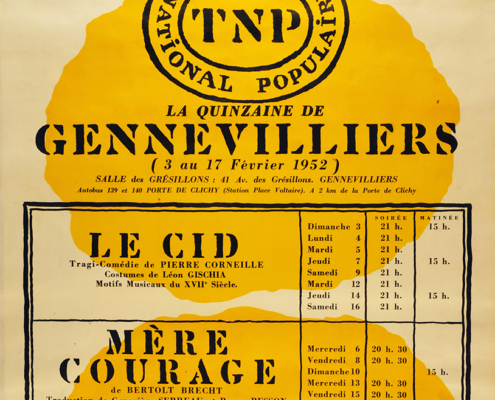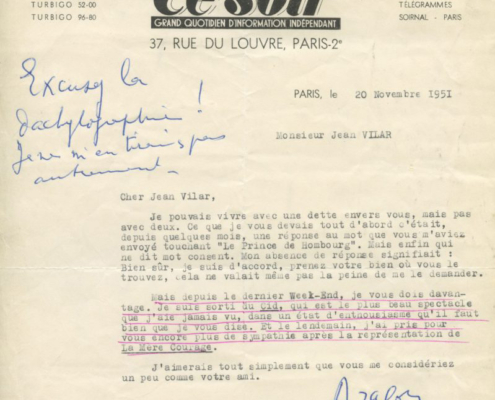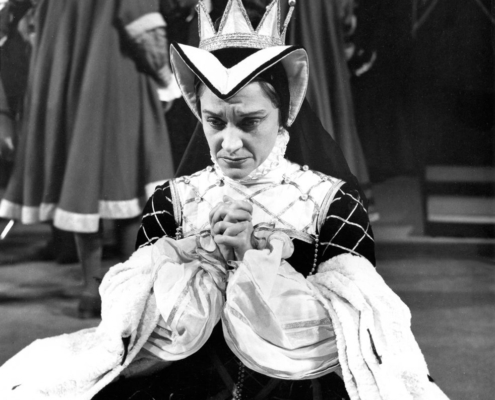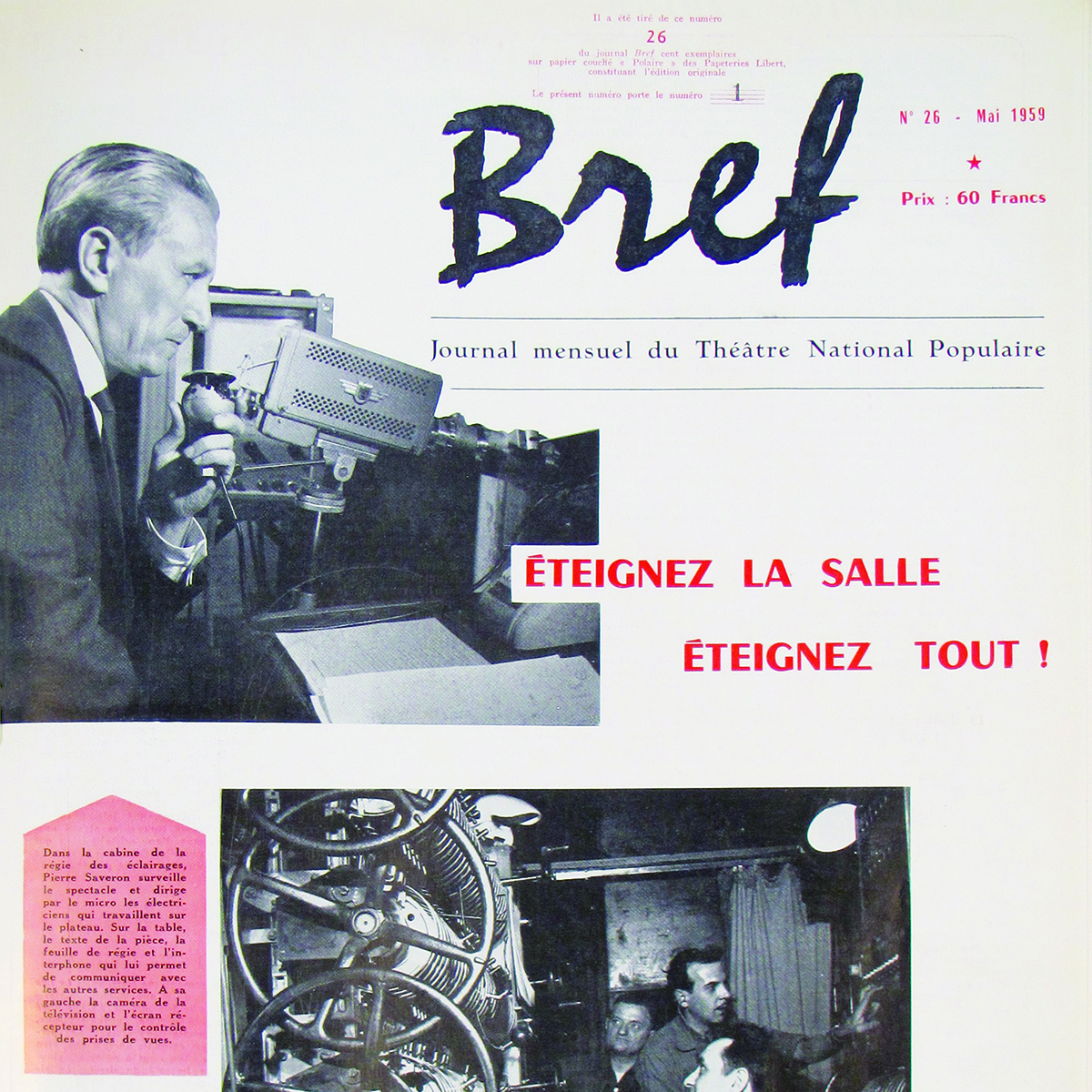Ressources and Collections
Living memory
Going into the Maison Jean Vilar is like descending into a cavern where you can still hear the echo of the clapping at the end of a show, the dialogues with the audience, discussions about the minor detail of a costume, the echo of tools putting the finishing touches to a set, the exchanges between actors and director…
Jean Vilar fought all his life for an inclusive theatre alive and open to the greatest number: l’Hôtel Crochans is filled with treasures that bring the memory of performing arts to life.
In the spirit of transmission always at the heart of their project, everyone is welcome – researchers, students, professionals, amateurs – to come and discover the different resources of the collection.
A whole segment of the history of 20th century theatre made freely available.
- The Jean Vilar collection includes his documents manuscrits, donated by Madame Andrée Vilar, supplemented by other gifts such as Jean Vilar’s correspondence with Gérard Philipe or documents related to his artistic partners (Jacno, Maurice Jarre, Édouard Pignon…)
- Photographies by Agnès Varda and many other photographers, videos of rehearsals (during the 50s and 60s), audio recordings of performances at the T.N.P. (1951-63), and posters designed by Marcel Jacno also make up an important part of the archives.
- Around 1200 costumes (and 1600 costume sketches) from all the shows created by Jean Vilar are preserved, along with the dressers’ ‘prompt books’ from the T.N.P.
- The library, an annex of the Arts section of the Bibliothèque Nationale de France, offers access to over 33,000 books and reviews on the performing arts along with archives and documents related to the different festivals and live shows in Avignon.
On the BnF “Archives and Manuscripts” website :
In addition to the Jean Vilar and Jean Rouvet collections, there are donations from the families of Gérard Philipe, Sonia Debeauvais and Germaine Montero, not to mention the donations of many anonymous spectators and festival-goers.
Costumes
Madame Andrée Vilar donated a collection of 1600 costume sketches, kept by her husband, to the Association Jean Vilar.
Through this multitude of gouaches the visitor can discover the aesthetic diversity of each painter’s style.
Each plate is both the trace of work by Jean Vilar’s associates and a drawing which forms part of the graphic environment of those great artists who worked alongside him: Leon Gischia, Mario Prassinos, Edouard Pignon, to name but a few.
Most of the costumes produced from these studies are kept in the basement of l’Hôtel de Crochans, which is maintained at a constant temperature. The 1,200 pieces are kept in 87 metal wardrobes.
After all this time, they still seem to keep the aura of the actors who wore them on the stage of the Cour d’Honneur, the Palais de Chaillot or touring France or internationally.
Manuscripts
The collection of manuscripts is a treasure trove of breathtaking proportions.
Of particular interest is Jean Vilar’s correspondence with his different associates, his memos, his personal reflections, and the stage directions he wrote on texts during rehearsals.
The “feuilles de salle”, or information sheets, an invention of Jean Vilar, are also kept at l’Hôtel de Crochans. Among them are analyses of the plays and questionnaires for the public: Where did you hear about this performance? Were the technical aspects satisfactory? Have you any comments to make about the stage direction?
The answers provided are a moving and precious resource for anyone interested in studying how audiences have evolved.
“It would be desirable for interested members of the audience to cut out unwarranted applause after each scene and even between monologues.” M.S. 16 years old, February 1958.
The Maison Jean Vilar also holds many documents relating to Jean Vilar’s childhood and private life.
Audio recordings
The Maison Jean Vilar possesses an extensive set of audio recordings on magnetic tape of performances at the Théâtre National Populaire de Chaillot, between 1951 and 1963 during Jean Vilar’s directorship.
Hearing the actors’ voices, their steps on the stage, the murmurs among the audience…
Feeling the sands of time, the now mythical intonations, the original music, the singing…
Delving into the post-performance debates, thanks to the meetings organized with the public…
Agnès Varda’s Photographs
From 1951, Jean Vilar asked his accomplice Agnès Varda, likewise a native of Sète, to take photographs of everything: rehearsals, performances and moments off stage. She built up the archives of the Festival, in her own style.
These images constitute a poignant and outstanding piece of documentation, recapturing the beginnings of the Festival up to 1960, when Agnès Varda took up a career in cinema.
It are also, without doubt, a milestone in the history of the work of this photographer and exceptional artist.
Les publications TNP
The Palais de Chaillot in Paris became the Théâtre National Populaire under the directorship of Jean Vilar from 1951 to 1963. During this period, he introduced a range of measures to facilitate access to the theatre even though it involved shaking things up: abolition of the tip system (from then on ushers were paid a salary), free cloakrooms, a change in performance schedules to avoid late nights, a wider range of ticket prices… but also the Collection des Répertoires which offered an alternative to individual programmes on sale. There was also les Brefs a monthly publication of the TNP, which gave information on what was happening in the different auditoriums and the life of the institution. These also acted as a platform offering a voice to the spectators.
Documents d’archives en relation
At the National Archives (FR) :
On the BnF “Archives and Manuscripts” website (FR) :
- Ensemble documentaire Festival d’Avignon – direction Jean Vilar (théâtre)
- Fonds Festival d’Avignon – direction : Puaux, Paul (théâtre)
- Fonds Théâtre national de Chaillot (Théâtre National Populaire) – 1951-1963, direction : Vilar, Jean (théâtre)
- Fonds Théâtre national de Chaillot (Théâtre national populaire) – 1963-1972, direction : Wilson, Georges (théâtre)
- Collection Casarès, Maria (théâtre, cinéma)
- Fonds Monfort, Silvia (théâtre)
- Fonds Philipe, Anne et Gérard (théâtre, cinéma, littérature)
















































